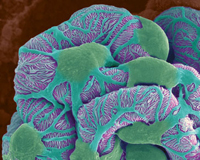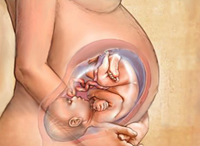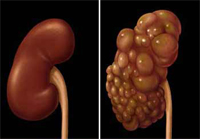Dysmetabolic nephropathy is a group of renal diseases associated with metabolic disorders. In progression of dysmetabolic nephropathy, kidney inflammation may occur (jade, pyelonephritis), urolithiasis, cystitis. Read how to eat right to avoid complications.
Content
Dysmetabolic nephropathy is a group of renal diseases whose development is associated with metabolic disorders.
 Recently, children are increasingly meeting exchange disorders that lead to elevated removal with urine of various salts — oxalates, urates, phosphates, etc. This is facilitated by environmental pollution, eating products with chemical additives, as well as hereditary factors. Children with exchange nephropathy have increased risk of urinary stones.
Recently, children are increasingly meeting exchange disorders that lead to elevated removal with urine of various salts — oxalates, urates, phosphates, etc. This is facilitated by environmental pollution, eating products with chemical additives, as well as hereditary factors. Children with exchange nephropathy have increased risk of urinary stones.
In progression of disometabolic nephropathy, kidney inflammation may occur (jade, pyelonephritis), urolithiasis, cystitis.
Dysmetabolic nephropathy manifests general symptoms of metabolic disorders and changes in the urine. Changes in the urine are manifested in the form of impurities of salts (oxalates, urates, phosphates, etc.), red blood cells, protein, leukocytes.
Causes of dysmetabolic nephropathy
The causes of dysmetabolic nephropathy can be:
- Various metabolic disorders (hereditary or acquired disorders of calcium exchange, oxalic acid, uric acid, cystine, phosphates)
- urinary tract infections
- stagnation of urine (for example, with a late emptying of the bladder, the narrowing of the urinary tract and others.)
- Endocrine sickness
- Diseases of the gastrointestinal tract (worms, giardiasis)
- oncology
- Reception of some drugs
- radiation therapy
Most often, dysmetabolic nephropathy occurs in the form of oxaluria (selection with urine oxalates) and urban (selection with urine urates)
Causes of oxaluria:
- hereditary defects of some enzymes
- Increased oxalate receipt with food
- Inflammatory bowel diseases
- Transferred transactions on the intestines
- Crohn's disease
- ulcerative colitis
- Vitamin B6 deficiency
- excessive consumption of ascorbic acid
Causes of Ulaturia:
- Inheritance causes (renal channel defect, reinforced meature of purines)
- Increased consumption of meat products
- Treatment of chemotherapy products
- Long reception of furosemide
Manifestations of dysmetabolic nephropathy
 Children under 5 do not have specific manifestations. In older children and adults: increased fatigue, abdominal pain, characterized by a fluid delay in the body, which is manifested by the edema of the eyelids, a decrease in the amount of urine secreted, with lower back pain. It is often observed itching, pain and redness in the field of external genital organs. Watering turbid, with a precipitate, on the walls of the pot is formed hardly washed raid. To clarify the diagnosis, the doctor prescribes the study of daily salt salts with urine.
Children under 5 do not have specific manifestations. In older children and adults: increased fatigue, abdominal pain, characterized by a fluid delay in the body, which is manifested by the edema of the eyelids, a decrease in the amount of urine secreted, with lower back pain. It is often observed itching, pain and redness in the field of external genital organs. Watering turbid, with a precipitate, on the walls of the pot is formed hardly washed raid. To clarify the diagnosis, the doctor prescribes the study of daily salt salts with urine.
Urine collected as follows. The first morning urination is not taken into account. All subsequent portions of urine, including the morning portion of the next day, merge into one bank, which is stored in a cool place. In the morning, the total daily amount of urine is measured, mixed well, then differ 200 ml for analysis.
Of mineral waters, it is better to use weakly in oxalate: Borjomi, Slavyanovskaya, Smirnovskaya. With urabular salts — Jermuk, Borjomi, Pri-Su. If phosphates are determined in urine tests, alkaline mineral waters are contraindicated.
Diet in the treatment of oxalateuria
Allowed:
Brussels, Color, White Cabbage, Apricots, Bananas, Bakhchy, Pears, Pumpkin, Cucumbers, Peas, All kinds of croup, White bread, Vegetable oil. Periodically — potato-cabbage diet. Potato-cabbage diet.
Limited:
Carrots, green beans, chicory, onions, tomatoes, strong tea, beef, chicken, bay, liver, cod, currants, Antonovskaya apples, radishes.
Excluded:
Chocolate, beets, celery, spinach, sornery, rhubarb, parsley, extractive substances (broths).
Diet in the treatment of ultrayuria
Allowed:
Dairy products in the first half of the day. Potato-cabbage diet. Color and white cabbage, cereals (buckwheat, oatmeal, millet, rice), fruit, drinkers, prunes, sea cabbage, wheat bran, creamy and vegetable oil, wheat bread, rye from coarse grinding. Low-fat meat and fish —3 times a week for 150 g. Senior children in boiled form in the first half of the day.
Limited:
Peas, beans, beef, chicken, rabbit.
Excludes:
Strong tea, cocoa, coffee, chocolate, sardines, animal liver, lentils, pork, offal, fatty fish, meat and fish broths.
Diet in the treatment of phosphatia
Allowed:
Butter butter, vegetable, rice, semolina cereals, pasta, top and first grade flour, potatoes, cabbage, carrots, cucumbers, beets, tomatoes, apricots, watermelon, pears, plum, strawberry, cherry.
Limited:
Beef, pork, sausage boiled, egg, corn croup, second grade flour, milk, sour cream.
Excludes:
Cheese, cottage cheese, beef liver, chicken, fish, caviar, beans, peas, chocolate, oatmeal, pearl, buckwheat, millet.
In the case of combined metabolic disorders, the diet is assigned individually.









